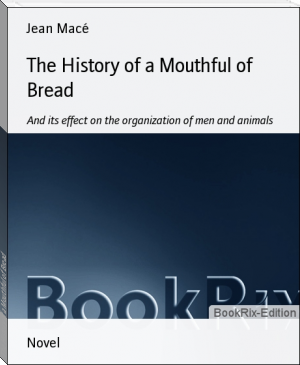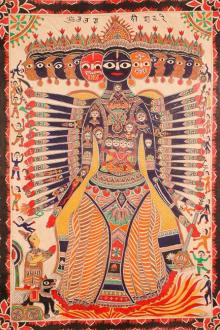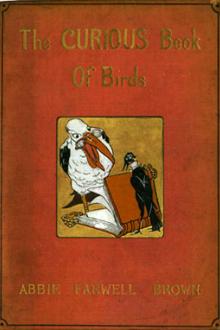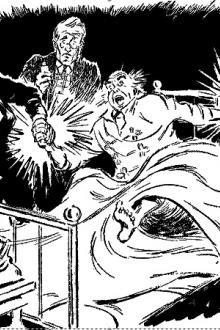The History of a Mouthful of Bread, Jean Macé [best autobiographies to read TXT] 📗

- Author: Jean Macé
Book online «The History of a Mouthful of Bread, Jean Macé [best autobiographies to read TXT] 📗». Author Jean Macé
insects. There it gives rise to an almost transparent sort of blood, a kind of sap, or lymph, which is put in motion by a genuine circulation-apparatus; a real heart, with all its canals. This heart has only one ventricle, and only sends blood in one direction, as in the case of fishes; but there is an essential difference between them, which we must point out. The heart of fishes may be called a venous heart, since it only receives venous blood, which passes thence to the gills, while that of crustaceans is an arterial heart. It receives the blood directly it leaves the respiratory organ, and sends it, not into one aorta, but into several arteries, which set out at once, each in its own direction, to nourish the various quarters of the body. This greatly resembles the system of circulation, with which we are already acquainted. The veins only are unsatisfactory. They form a kind of transition between the uncertain currents which convey the blood of insects from one end to the other of the cavity in which these strange organs lie bathed, and the closed canals of the higher animals. But they are not canals, properly speaking. The irregular intervals which separate the organs, more numerous here, are enclosed by membranes, between which the venous blood pours, and naturally the chyle also. The whole thus arrives at certain excavations formed at the place where the legs are jointed on to the body-reservoirs, so to speak-where the real canals come to carry it off and convey it away into the gills.
It is, in fact, by means of gills that crustaceans breathe in their character of aquatic animals. These gills are made nearly upon the same model as we have already seen in those of fishes; and although their form and arrangement differ in different species, yet the principle is always the same: they are tufts of leaflets springing from stems, up and down which run two tubes; one which brings the blood from the venous reservoirs, the other which carries it to the heart. Crabs, lobsters, and crayfish, who are the "file-leaders" of the crustacean tribe, have gills enclosed in the body, as fishes have; but the circulation of the water goes in a contrary direction to theirs, as does that of the blood. Instead of entering at the mouth and going out at the sides, as we have seen, it enters at the edge of the bony shell which covers over the body and comes out near the mouth-a merely accidental detail which does not in any way alter the play of the apparatus. All these animals are equally adapted for swimming and for walking, crabs especially, their gills accommodating themselves without difficulty to contact with the outer air, as we have seen among certain fishes; so that one might class them with amphibians. There is even one crab who has acquired the name of land-crab , because, although he has got gills, he dies in water, the small amount of air he can get out of it at a time being insufficient for him, and who, therefore, lives constantly on land. It is true that he seeks out damp spots, for his gills would also fail him if they became parched, and, like the fishes who make excursions on dry land, he is provided with an internal reservoir, which is always filled with a certain quantity of water.
Some aquatic crustaceans have the labor simplified by external gills, which hang down into the water, sometimes depending from the stomach, sometimes from the legs. In France you sometimes see at a table certain little animals, very like shrimps ( squillæ ), the bases of whose hinder legs are fringed by slender tufts, which are in fact their gills. They find themselves placed there just within reach of the venous blood; for in the body opposite the bases of the legs are little cavities in which it accumulates. Now these gills can only act when under water, and so the squillæ dies as soon as he is removed from that protecting element. For the same reason they cannot be kept long, nor travel far, much to the regret of those who like them and live at some distance from the sea.
There are other crustaceans, next-door neighbors of the squilla, whose gills are still more simplified. Here the legs themselves are turned into extremely thin plates, which play the part of gills, and are thus organs for two purposes, serving at the same time to swim and breathe with.
We have in our house one little crustacean, the only one I know of who associates with men, and that is the wood-louse. You must know the little grizzly beast, which rolls itself up into a ball whenever it thinks itself in danger, and who would be taken for an insect by anyone who was not taught otherwise. The wood-louse has neither gills hanging down outside, nor anything inside her body which resembles the breathing apparatus of her great relations. But, on examining her closely, you will perceive all along her stomach a series of little plates, which are her breathing-organs, and which come under the class of gills, because, like other gills, they require a certain degree of moisture to make them act properly. You will never, therefore, see a wood-louse strutting about in the sunshine, where he would dry up far too quickly; but if ever you get into a dark, damp corner, there you have every chance of finding one.
Animals who breathe through their legs and through their stomachs! You are astonished, and ask, What are we coming to? What would you say, then, if I were to go really to the depths of the crustacean world? We should find there such extraordinary beings as you can form no notion of, for they all live down below in the sea, and have no special breathing-organ at all, inasmuch as they breathe through the whole surface of the body. Do not exclaim yet! I will soon show you one whom you know perfectly well, and who has no other way of breathing.
But we must keep to the higher crustaceans, if we want to judge of the class. By going too low, we run the risk of not seeing clearly. Animal creation is here on a system of experiments: and they are so endlessly multiplied, and exhibit such a profusion both of deceptive resemblances, and of differences which disappear by transformations, that classification no longer knows which way to turn. Worms, crustaceans, mollusks; to which group do these and those belong? To which ever we like to refer them, for these groups represent nothing definitely determined in the plan of creation; and though easy to be distinguished from each other in the higher branches, they become confused together in the lower, like mountain summits which spring from a common base, at the foot of which they are all united together.
On this account, my dear child, you will, I am sure, excuse me now and henceforth, from entering into details of all the horrible beasts which swarm in the shallows of the animal world, and whom learned men have in their wonderful wisdom muffled up in terrible names, in order to prevent children from coming near them! What would you have thought of the poor little squilla, so prettily baptised by the fishermen, if I had taught you that it belonged to the order of Stomatopoda ? You will scarcely be able to pronounce the word; but that is no fault of mine, it is spelt so.
We will content ourselves, then, with having taken a glance at the most clearly marked individuals; and as I said to you just now, it is by them that we will arrange our inventory of the groups. Here, as you may have already remarked, instead of continuing to wander from the original model whose gradual deterioration we have been following all this time from one class to another, it would seem that we are retracing our steps, and regaining some portion of the lost ground. This is because insects, as I have already stated, are an exceptional case-an idea apart from the great general plan-a by-lane turning off from one side of the great line of animal creation.
The crustacean, less perfectly worked out than the insect assuredly, but more regular, forms, so to speak, the connecting line between that tiny masterpiece of fancy, so incomplete in its exquisite organisation, and the shapeless but better constituted lump of the mollusk, who conceals under his heavy shell the sacred deposit of real organs, those which we expect to find always and everywhere. An insect outside, though less refined it is true, a mollusk within, the crustacean reminds me of what among us is called an amateur -that mild lover of the arts who holds a middle place, as it were, between the artist and the common citizen.
I regret that you are not at present quite able to appreciate my comparison fully: but put it by, in reserve, if possible, in your memory; you will find out hereafter how just it is, and it will, perhaps, help to prevent you from always setting the lively, noisy artist, above the quiet and silent citizen. Let this, however, be between you and me. If they could hear us talking, neither artist nor citizen would forgive me, and the amateur still less.
Mollusks.
There is one mollusk universally well known-namely, the oyster-so we will choose him for discussion. To look on one's plate at that little mass of soft, compact substance, one feels inclined to ask what there can possibly be in common between it and us; and if you were to declare that there was not the faintest trace of resemblance between the organization of the oyster and our own, I should not be surprised. Wiser people than you have been caught tripping there; not that they were ignorant of the points in which the oyster resembled us, but they paid no attention to them. Viewing it in other respects, they declared that it was of a structure completely different to our own; and that, in the construction of this machine, the Creator had worked upon a particular plan, laid aside afterwards as useless for any other purpose.
I should like to get hold of one of those Academicians, with thirty-six plans, and confound him before you, in proof of his relationship to the oyster, by showing you at one sitting that there is an oyster in himself; nay, further, that he is nothing but an oyster, revised, amended, and considerably enlarged. And do not imagine that I am only using a figure of speech here, as the professors of rhetoric call it; which would be in bad taste: I am speaking literally, and to prove the existence of the oyster in question in our Academician, I shall only ask permission to perform a slight operation upon him. You exclaim at this; but do not alarm yourself, for it is only an operation on paper, he will not die from it. See now, I cut off his head, his two arms, and his legs; I take out of his body the vertebral column and the ribs; I gently place what remains between two shells; and ... there is my oyster. I willingly admit that it is more carefully elaborated and richer in details than its sisters in the oyster beds; but all the principal organs are to be found in them also, and they positively are beings of a similar construction: you shall judge for yourself.
The mouth-for there is a mouth, though one must look closer than the oystermen do to discover it-the mouth is exactly what the gullet (oesophagus) would be in a man whose head had been cut off; that
It is, in fact, by means of gills that crustaceans breathe in their character of aquatic animals. These gills are made nearly upon the same model as we have already seen in those of fishes; and although their form and arrangement differ in different species, yet the principle is always the same: they are tufts of leaflets springing from stems, up and down which run two tubes; one which brings the blood from the venous reservoirs, the other which carries it to the heart. Crabs, lobsters, and crayfish, who are the "file-leaders" of the crustacean tribe, have gills enclosed in the body, as fishes have; but the circulation of the water goes in a contrary direction to theirs, as does that of the blood. Instead of entering at the mouth and going out at the sides, as we have seen, it enters at the edge of the bony shell which covers over the body and comes out near the mouth-a merely accidental detail which does not in any way alter the play of the apparatus. All these animals are equally adapted for swimming and for walking, crabs especially, their gills accommodating themselves without difficulty to contact with the outer air, as we have seen among certain fishes; so that one might class them with amphibians. There is even one crab who has acquired the name of land-crab , because, although he has got gills, he dies in water, the small amount of air he can get out of it at a time being insufficient for him, and who, therefore, lives constantly on land. It is true that he seeks out damp spots, for his gills would also fail him if they became parched, and, like the fishes who make excursions on dry land, he is provided with an internal reservoir, which is always filled with a certain quantity of water.
Some aquatic crustaceans have the labor simplified by external gills, which hang down into the water, sometimes depending from the stomach, sometimes from the legs. In France you sometimes see at a table certain little animals, very like shrimps ( squillæ ), the bases of whose hinder legs are fringed by slender tufts, which are in fact their gills. They find themselves placed there just within reach of the venous blood; for in the body opposite the bases of the legs are little cavities in which it accumulates. Now these gills can only act when under water, and so the squillæ dies as soon as he is removed from that protecting element. For the same reason they cannot be kept long, nor travel far, much to the regret of those who like them and live at some distance from the sea.
There are other crustaceans, next-door neighbors of the squilla, whose gills are still more simplified. Here the legs themselves are turned into extremely thin plates, which play the part of gills, and are thus organs for two purposes, serving at the same time to swim and breathe with.
We have in our house one little crustacean, the only one I know of who associates with men, and that is the wood-louse. You must know the little grizzly beast, which rolls itself up into a ball whenever it thinks itself in danger, and who would be taken for an insect by anyone who was not taught otherwise. The wood-louse has neither gills hanging down outside, nor anything inside her body which resembles the breathing apparatus of her great relations. But, on examining her closely, you will perceive all along her stomach a series of little plates, which are her breathing-organs, and which come under the class of gills, because, like other gills, they require a certain degree of moisture to make them act properly. You will never, therefore, see a wood-louse strutting about in the sunshine, where he would dry up far too quickly; but if ever you get into a dark, damp corner, there you have every chance of finding one.
Animals who breathe through their legs and through their stomachs! You are astonished, and ask, What are we coming to? What would you say, then, if I were to go really to the depths of the crustacean world? We should find there such extraordinary beings as you can form no notion of, for they all live down below in the sea, and have no special breathing-organ at all, inasmuch as they breathe through the whole surface of the body. Do not exclaim yet! I will soon show you one whom you know perfectly well, and who has no other way of breathing.
But we must keep to the higher crustaceans, if we want to judge of the class. By going too low, we run the risk of not seeing clearly. Animal creation is here on a system of experiments: and they are so endlessly multiplied, and exhibit such a profusion both of deceptive resemblances, and of differences which disappear by transformations, that classification no longer knows which way to turn. Worms, crustaceans, mollusks; to which group do these and those belong? To which ever we like to refer them, for these groups represent nothing definitely determined in the plan of creation; and though easy to be distinguished from each other in the higher branches, they become confused together in the lower, like mountain summits which spring from a common base, at the foot of which they are all united together.
On this account, my dear child, you will, I am sure, excuse me now and henceforth, from entering into details of all the horrible beasts which swarm in the shallows of the animal world, and whom learned men have in their wonderful wisdom muffled up in terrible names, in order to prevent children from coming near them! What would you have thought of the poor little squilla, so prettily baptised by the fishermen, if I had taught you that it belonged to the order of Stomatopoda ? You will scarcely be able to pronounce the word; but that is no fault of mine, it is spelt so.
We will content ourselves, then, with having taken a glance at the most clearly marked individuals; and as I said to you just now, it is by them that we will arrange our inventory of the groups. Here, as you may have already remarked, instead of continuing to wander from the original model whose gradual deterioration we have been following all this time from one class to another, it would seem that we are retracing our steps, and regaining some portion of the lost ground. This is because insects, as I have already stated, are an exceptional case-an idea apart from the great general plan-a by-lane turning off from one side of the great line of animal creation.
The crustacean, less perfectly worked out than the insect assuredly, but more regular, forms, so to speak, the connecting line between that tiny masterpiece of fancy, so incomplete in its exquisite organisation, and the shapeless but better constituted lump of the mollusk, who conceals under his heavy shell the sacred deposit of real organs, those which we expect to find always and everywhere. An insect outside, though less refined it is true, a mollusk within, the crustacean reminds me of what among us is called an amateur -that mild lover of the arts who holds a middle place, as it were, between the artist and the common citizen.
I regret that you are not at present quite able to appreciate my comparison fully: but put it by, in reserve, if possible, in your memory; you will find out hereafter how just it is, and it will, perhaps, help to prevent you from always setting the lively, noisy artist, above the quiet and silent citizen. Let this, however, be between you and me. If they could hear us talking, neither artist nor citizen would forgive me, and the amateur still less.
Mollusks.
There is one mollusk universally well known-namely, the oyster-so we will choose him for discussion. To look on one's plate at that little mass of soft, compact substance, one feels inclined to ask what there can possibly be in common between it and us; and if you were to declare that there was not the faintest trace of resemblance between the organization of the oyster and our own, I should not be surprised. Wiser people than you have been caught tripping there; not that they were ignorant of the points in which the oyster resembled us, but they paid no attention to them. Viewing it in other respects, they declared that it was of a structure completely different to our own; and that, in the construction of this machine, the Creator had worked upon a particular plan, laid aside afterwards as useless for any other purpose.
I should like to get hold of one of those Academicians, with thirty-six plans, and confound him before you, in proof of his relationship to the oyster, by showing you at one sitting that there is an oyster in himself; nay, further, that he is nothing but an oyster, revised, amended, and considerably enlarged. And do not imagine that I am only using a figure of speech here, as the professors of rhetoric call it; which would be in bad taste: I am speaking literally, and to prove the existence of the oyster in question in our Academician, I shall only ask permission to perform a slight operation upon him. You exclaim at this; but do not alarm yourself, for it is only an operation on paper, he will not die from it. See now, I cut off his head, his two arms, and his legs; I take out of his body the vertebral column and the ribs; I gently place what remains between two shells; and ... there is my oyster. I willingly admit that it is more carefully elaborated and richer in details than its sisters in the oyster beds; but all the principal organs are to be found in them also, and they positively are beings of a similar construction: you shall judge for yourself.
The mouth-for there is a mouth, though one must look closer than the oystermen do to discover it-the mouth is exactly what the gullet (oesophagus) would be in a man whose head had been cut off; that
Free e-book «The History of a Mouthful of Bread, Jean Macé [best autobiographies to read TXT] 📗» - read online now
Similar e-books:





Comments (0)